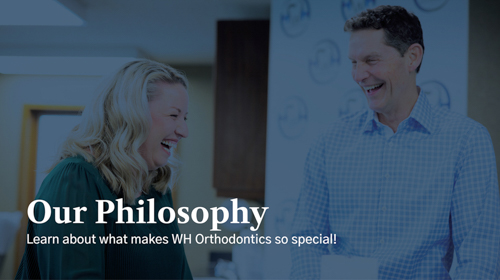You’ve spent months and months in braces or Invisalign to perfect your smile. The last thing you want now is for all that to go to waste. That’s why you need to wear retainers after braces.
The “retention” phase of treatment begins after the Wilson & Hendrickson Orthodontics doctors remove your braces or clear aligners. That means you’ll be fitted with retainers that will be customized to keep your smile in perfect shape!
What is a retainer? How long do you have to wear a retainer? What are the types of retainers for teeth? Wilson & Hendrickson Orthodontics has the answers!
What Is a Retainer?
Why is it important to wear a retainer? Thanks to your braces or clear aligners, your teeth have spent months moving into place. Once your braces or Invisalign come off, your teeth will keep moving unless something stops them.
Consistently wearing your retainer is essential to prevent your teeth from returning to their original positions. Wearing retainers keeps your teeth in place while your jaw hardens around them, and your periodontal ligaments get used to holding the position of your teeth.
Your retainer will be made based on scans of your new smile. They are custom-made for your mouth to keep your smile beautiful for years.
Types of Retainers
There are three main types of retainers. We offer the two most common types, Hawley and Essix retainers. The third type is called permanent retainers or lingual retainers.
Hawley Retainers
This is the traditional retainer most people picture when they hear “retainers.” It is a custom-molded acrylic mouthpiece that holds wires that fit over your teeth to keep them in place. This retainer pops onto and off your teeth and can be removed for easy cleaning.
Essix Retainers
These are also called Vivera or clear retainers. Essix retainers are similar to clear aligners in that they are acrylic and molded to cover the teeth completely. They are meant to keep teeth in place and are removable for easy cleaning.
Invisalign retainers are called Vivera retainers. These clear retainers are part of the Invisalign treatment system and are created in the same way we create your Invisalign clear aligners during your treatment. Otherwise, there is little difference between Essix vs. Vivera retainers.
Permanent Retainers
Permanent retainers are bonded retainers that go across the back of your front teeth. They are usually made up of a single, thick wire that fits behind the upper and lower incisors.
The problem with permanent retainers is that it is very easy for tartar to build up around the retainers. It is crucial to be extra vigilant to keep the area around the retainer clean and free of plaque.
Do Retainers Hurt?
Do retainers hurt your teeth? There will be a period of adjustment after you get your retainers, just like there was when you first got your braces or Invisalign. You may experience some minor and temporary symptoms as your mouth adjusts.
Among these symptoms, most commonly reported are difficulty talking normally (a retainer lisp) and producing more saliva than normal. You shouldn’t be sore like with braces since your retainers are holding your teeth in place instead of moving them.
After a short period of consistent use, you will hardly notice you are wearing a retainer at all. Any temporary symptoms should disappear within a week or two.
How Long Do You Have to Wear a Retainer?
When you get your new retainers, we will instruct you to wear your retainer all day, 24/7, except to eat or brush and floss your teeth. You will do this for several months, possibly up to a year. Why do you have to wear a retainer 24/7? Your jaw needs 3-6 months at least to harden properly and hold your teeth better.
After that, we’ll inform you when you can switch to wearing your retainers overnight only. As time goes on, you may need to only wear them a few nights a week. It’s vital you continue to wear your retainers consistently to keep your teeth from moving.
We’ve heard it before: “I haven’t worn my retainer in months, and it hurts.” That’s because without consistent retainer use, your teeth will move out of place. We can’t stress enough how important it is to wear your retainer!
We will examine you during regular checkups a few times a year to determine how much you need to wear your retainer. The idea is to reduce the time you need in a retainer without losing that beautiful new smile!
How to Clean a Retainer and Keep It Safe
Your retainers are designed to last you a lifetime. Chances are you’ll need to replace them eventually, but with proper care, you can hang onto them for years. Do you have to wear a retainer forever? Technically, you should, but you need to wear it consistently for a few years, at least.
You can keep your retainer fresh and germ-free through proper cleaning, and proper storage can keep them safe. Can you eat with retainers? We recommend you remove them to eat and brush your teeth.
The following suggestions will help you maintain and protect your retainer throughout your retention process.
- Clean your removable retainer with a soft toothbrush and dishwashing liquid/mild liquid soap. You can use antibacterial soap with retainers, just make sure it’s clear and not colored.
- Use special retainer cleaner tablets. Be careful with denture cleansers, particularly with clear retainers. Some tablets contain abrasives that can make your retainers look cloudy.
- Clean fixed retainers by brushing and flossing; a floss threader or interproximal brush can also be a helpful cleaning tool when needed.
- Use safe cleaning alternatives. If cleaning tablets aren’t available, you can use white distilled vinegar or baking soda diluted in lukewarm water to clean your retainers. Be sure to rinse them thoroughly before putting them in your mouth.
- Use a soft-bristled brush or cotton swab. If you have food particles or plaque trapped in the crevices of your retainers, use a cotton swab or a soft-bristled toothbrush to remove them. Don’t use toothpaste! Abrasive material in the toothpaste can cause microabrasions on your retainers that will turn them cloudy over time.
- Do not expose your retainer to excess heat (dishwashers, very hot water, or leaving it on a heater). High temperatures can cause the retainers to warp and make it unusable.
- Always carry and use a retainer case. Do not wrap your retainer in napkins or tissues; many retainers are accidentally discarded when improperly stored.
Retainers In Topeka, KS
At Wilson & Hendrickson Orthodontics, we understand the hard work you invested in your smile. Let us help you maintain it! The key is to follow your instructions on wearing, cleaning, and protecting your retainers. Together, we can make your smile last!
If you have more questions about retainers or any part of orthodontic treatment, you can contact us at our Topeka, KS, office or schedule an appointment to visit with us. We look forward to seeing you!








